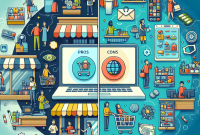
From Brick-and-Mortar to Click-and-Order: The Evolution of E-commerce
In the fast-paced world of retail, e-commerce has emerged as a game-changer, reshaping the way consumers shop and businesses operate. From the traditional brick-and-mortar stores to the convenience of online shopping, the evolution of e-commerce has revolutionized the retail landscape.
The Rise of E-commerce
E-commerce, short for electronic commerce, refers to the buying and selling of goods and services over the internet. The concept of e-commerce dates back to the 1970s, but it wasn’t until the 1990s that it gained widespread popularity with the advent of the World Wide Web. Online marketplaces like Amazon and eBay paved the way for the growth of e-commerce, offering consumers a new way to shop without leaving the comfort of their homes.
The Shift from Brick-and-Mortar to Click-and-Order
With the rise of e-commerce, traditional brick-and-mortar retailers were forced to adapt to the changing landscape. Many established retailers began investing in online platforms to reach a wider audience and stay competitive in the digital age. This shift from brick-and-mortar stores to click-and-order platforms marked a significant turning point in the retail industry.
The Benefits of E-commerce
One of the key benefits of e-commerce is convenience. With just a few clicks, consumers can browse through a vast array of products, compare prices, and make purchases from anywhere at any time. E-commerce also offers businesses the opportunity to reach a global audience, reducing the limitations of physical storefronts and extending their market reach.
The Impact of E-commerce on Consumer Behavior
The evolution of e-commerce has had a profound impact on consumer behavior. The rise of online shopping has led to changes in how consumers research products, make purchasing decisions, and interact with brands. With the convenience of e-commerce, consumers have come to expect seamless shopping experiences and personalized recommendations.
Challenges and Opportunities in E-commerce
While e-commerce offers numerous benefits, it also presents challenges for businesses. Competition in the online space is fierce, and businesses must constantly adapt to changing consumer trends and technological advancements. However, e-commerce also presents opportunities for businesses to expand their reach, offer personalized shopping experiences, and leverage data analytics to better understand their customers.
FAQs
What is the difference between brick-and-mortar and e-commerce?
Brick-and-mortar refers to traditional physical stores, while e-commerce refers to online platforms where goods and services are bought and sold over the internet.
How has e-commerce impacted the retail industry?
E-commerce has revolutionized the retail industry by offering consumers convenience, access to a wider range of products, and the ability to shop anytime, anywhere.
What are some examples of successful e-commerce companies?
Some examples of successful e-commerce companies include Amazon, Alibaba, eBay, and Shopify.
Conclusion
The evolution of e-commerce from brick-and-mortar to click-and-order platforms has transformed the retail landscape, offering consumers convenience and businesses new opportunities to grow and innovate. As e-commerce continues to evolve, it is essential for businesses to stay ahead of the curve and adapt to changing consumer preferences and technological advancements. The future of retail lies in the seamless integration of online and offline experiences, creating a truly omnichannel shopping environment for consumers.






